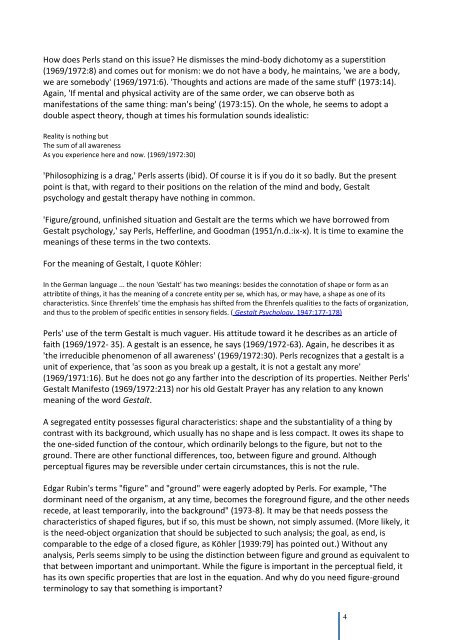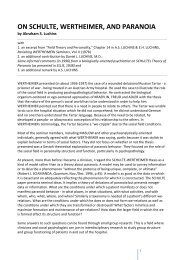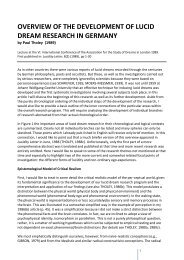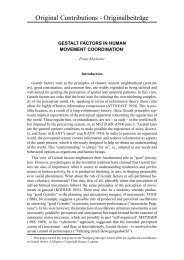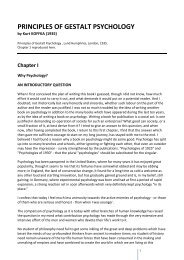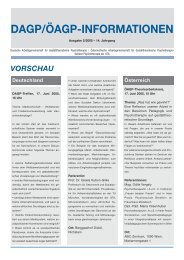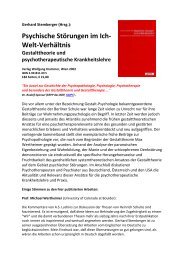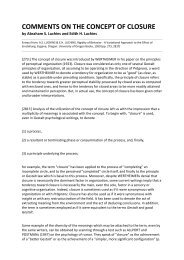Mary HENLE - Society for Gestalt Theory and its Applications (GTA)
Mary HENLE - Society for Gestalt Theory and its Applications (GTA)
Mary HENLE - Society for Gestalt Theory and its Applications (GTA)
- No tags were found...
You also want an ePaper? Increase the reach of your titles
YUMPU automatically turns print PDFs into web optimized ePapers that Google loves.
How does Perls st<strong>and</strong> on this issue? He dismisses the mind-body dichotomy as a superstition(1969/1972:8) <strong>and</strong> comes out <strong>for</strong> monism: we do not have a body, he maintains, 'we are a body,we are somebody' (1969/1971:6). 'Thoughts <strong>and</strong> actions are made of the same stuff' (1973:14).Again, 'If mental <strong>and</strong> physical activity are of the same order, we can observe both asmanifestations of the same thing: man's being' (1973:15). On the whole, he seems to adopt adouble aspect theory, though at times his <strong>for</strong>mulation sounds idealistic:Reality is nothing butThe sum of all awarenessAs you experience here <strong>and</strong> now. (1969/1972:30)'Philosophizing is a drag,' Perls asserts (ibid). Of course it is if you do it so badly. But the presentpoint is that, with regard to their positions on the relation of the mind <strong>and</strong> body, <strong>Gestalt</strong>psychology <strong>and</strong> gestalt therapy have nothing in common.'Figure/ground, unfinished situation <strong>and</strong> <strong>Gestalt</strong> are the terms which we have borrowed from<strong>Gestalt</strong> psychology,' say Perls, Hefferline, <strong>and</strong> Goodman (1951/n.d.:ix-x). lt is time to examine themeanings of these terms in the two contexts.For the meaning of <strong>Gestalt</strong>, I quote Köhler:In the German language ... the noun '<strong>Gestalt</strong>' has two meanings: besides the connotation of shape or <strong>for</strong>m as anattribtite of things, it has the meaning of a concrete entity per se, which has, or may have, a shape as one of <strong>its</strong>characteristics. Since Ehrenfels' time the emphasis has shifted from the Ehrenfels qualities to the facts of organization,<strong>and</strong> thus to the problem of specific entities in sensory fields. ( <strong>Gestalt</strong> Psychology, 1947:177-178)Perls' use of the term <strong>Gestalt</strong> is much vaguer. His attitude toward it he describes as an article offaith (1969/1972- 35). A gestalt is an essence, he says (1969/1972-63). Again, he describes it as'the irreducible phenomenon of all awareness' (1969/1972:30). Perls recognizes that a gestalt is aunit of experience, that 'as soon as you break up a gestalt, it is not a gestalt any more'(1969/1971:16). But he does not go any farther into the description of <strong>its</strong> properties. Neither Perls'<strong>Gestalt</strong> Manifesto (1969/1972:213) nor his old <strong>Gestalt</strong> Prayer has any relation to any knownmeaning of the word <strong>Gestalt</strong>.A segregated entity possesses figural characteristics: shape <strong>and</strong> the substantiality of a thing bycontrast with <strong>its</strong> background, which usually has no shape <strong>and</strong> is less compact. It owes <strong>its</strong> shape tothe one-sided function of the contour, which ordinarily belongs to the figure, but not to theground. There are other functional differences, too, between figure <strong>and</strong> ground. Althoughperceptual figures may be reversible under certain circumstances, this is not the rule.Edgar Rubin's terms "figure" <strong>and</strong> "ground" were eagerly adopted by Perls. For example, "Thedorminant need of the organism, at any time, becomes the <strong>for</strong>eground figure, <strong>and</strong> the other needsrecede, at least temporarily, into the background" (1973-8). lt may be that needs possess thecharacteristics of shaped figures, but if so, this must be shown, not simply assumed. (More likely, itis the need-object organization that should be subjected to such analysis; the goal, as end, iscomparable to the edge of a closed figure, as Köhler [1939:79] has pointed out.) Without anyanalysis, Perls seems simply to be using the distinction between figure <strong>and</strong> ground as equivalent tothat between important <strong>and</strong> unimportant. While the figure is important in the perceptual field, ithas <strong>its</strong> own specific properties that are lost in the equation. And why do you need figure-groundterminology to say that something is important?4


